Page 3932 of 4500
INSPECTION PROCEDURE
1.INSPECT FUSE (D/C CUT, D P/SEAT, MPX-IG, AM1, MPX-B1)
a. Remove the D/C CUT fuse from the FL block.
b. Remove the D P/SEAT, MPX-IG and AM1 fuses from the driver side J/B.
c. Remove the MPX-B1 fuse from the passenger side J/B.
d. Measure the resistance of the fuse.
Standard: Below 1 ohms
NG: REPLACE FUSE
OK: GO TO NEXT STEP
2.INSPECT RELAY (Marking: D-IG1)
a. Remove the D-IG1 relay from the driver side J/B.
b. Measure the resistance of the relay.
Standard:
TESTER CONNECTION AND SPECIFIED CONDITION
Tester connectionSpecified condition
3 - 510 kohms or higher
3 - 5Below 1 ohms (when battery voltage is applied to terminals 1 and 2)
Page 3944 of 4500
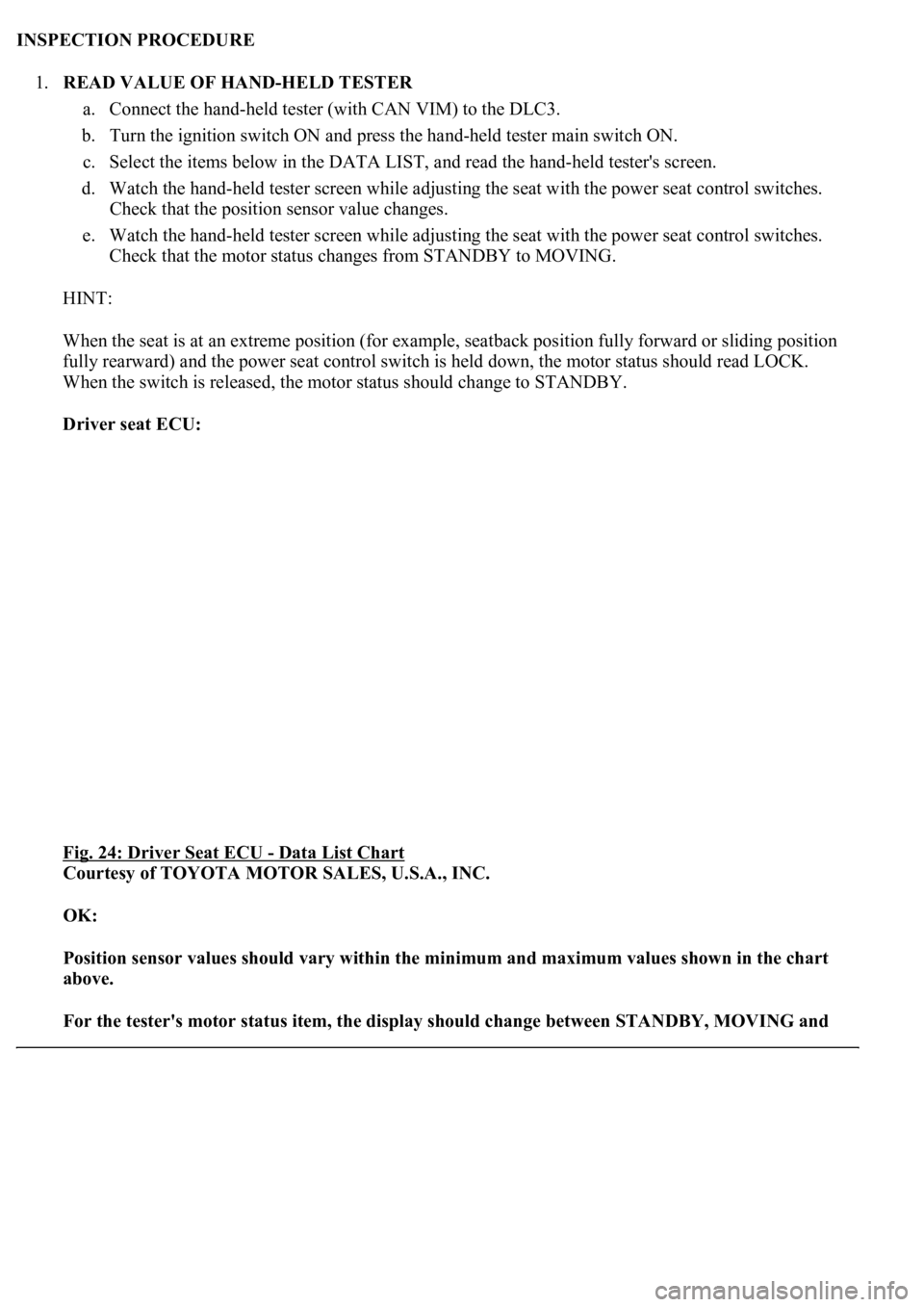
INSPECTION PROCEDURE
1.READ VALUE OF HAND-HELD TESTER
a. Connect the hand-held tester (with CAN VIM) to the DLC3.
b. Turn the ignition switch ON and press the hand-held tester main switch ON.
c. Select the items below in the DATA LIST, and read the hand-held tester's screen.
d. Watch the hand-held tester screen while adjusting the seat with the power seat control switches.
Check that the position sensor value changes.
e. Watch the hand-held tester screen while adjusting the seat with the power seat control switches.
Check that the motor status changes from STANDBY to MOVING.
HINT:
When the seat is at an extreme position (for example, seatback position fully forward or sliding position
fully rearward) and the power seat control switch is held down, the motor status should read LOCK.
When the switch is released, the motor status should change to STANDBY.
Driver seat ECU:
Fig. 24: Driver Seat ECU
- Data List Chart
Courtesy of TOYOTA MOTOR SALES, U.S.A., INC.
OK:
Position sensor values should vary within the minimum and maximum values shown in the chart
above.
For the tester's motor status item, the display should change between STANDBY, MOVING and
Page 3945 of 4500
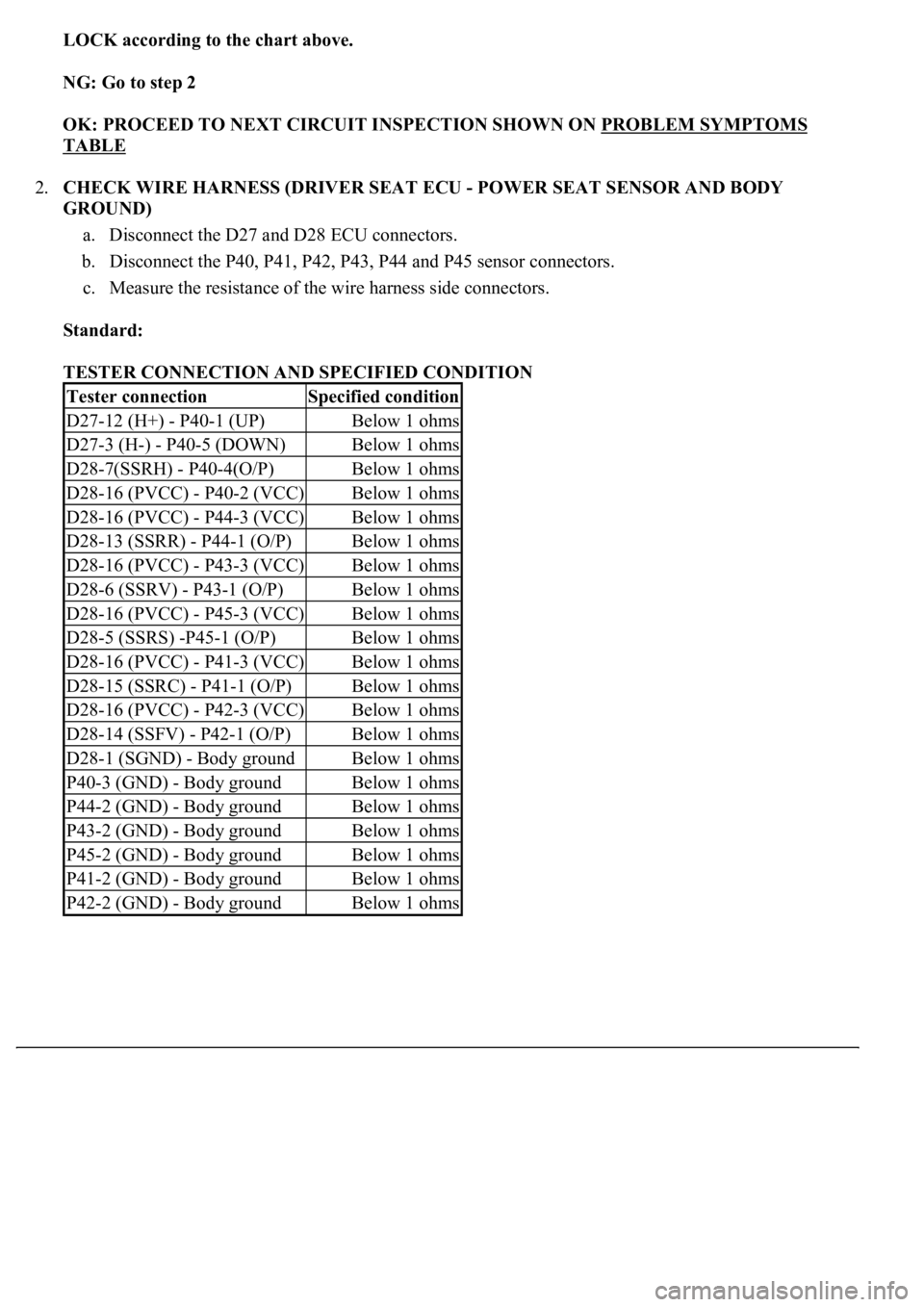
LOCK according to the chart above.
NG: Go to step 2
OK: PROCEED TO NEXT CIRCUIT INSPECTION SHOWN ON PROBLEM SYMPTOMS
TABLE
2.CHECK WIRE HARNESS (DRIVER SEAT ECU - POWER SEAT SENSOR AND BODY
GROUND)
a. Disconnect the D27 and D28 ECU connectors.
b. Disconnect the P40, P41, P42, P43, P44 and P45 sensor connectors.
c. Measure the resistance of the wire harness side connectors.
Standard:
TESTER CONNECTION AND SPECIFIED CONDITION
Tester connectionSpecified condition
D27-12 (H+) - P40-1 (UP)Below 1 ohms
D27-3 (H-) - P40-5 (DOWN)Below 1 ohms
D28-7(SSRH) - P40-4(O/P)Below 1 ohms
D28-16 (PVCC) - P40-2 (VCC)Below 1 ohms
D28-16 (PVCC) - P44-3 (VCC)Below 1 ohms
D28-13 (SSRR) - P44-1 (O/P)Below 1 ohms
D28-16 (PVCC) - P43-3 (VCC)Below 1 ohms
D28-6 (SSRV) - P43-1 (O/P)Below 1 ohms
D28-16 (PVCC) - P45-3 (VCC)Below 1 ohms
D28-5 (SSRS) -P45-1 (O/P)Below 1 ohms
D28-16 (PVCC) - P41-3 (VCC)Below 1 ohms
D28-15 (SSRC) - P41-1 (O/P)Below 1 ohms
D28-16 (PVCC) - P42-3 (VCC)Below 1 ohms
D28-14 (SSFV) - P42-1 (O/P)Below 1 ohms
D28-1 (SGND) - Body groundBelow 1 ohms
P40-3 (GND) - Body groundBelow 1 ohms
P44-2 (GND) - Body groundBelow 1 ohms
P43-2 (GND) - Body groundBelow 1 ohms
P45-2 (GND) - Body groundBelow 1 ohms
P41-2 (GND) - Body groundBelow 1 ohms
P42-2 (GND) - Body groundBelow 1 ohms
Page 3965 of 4500
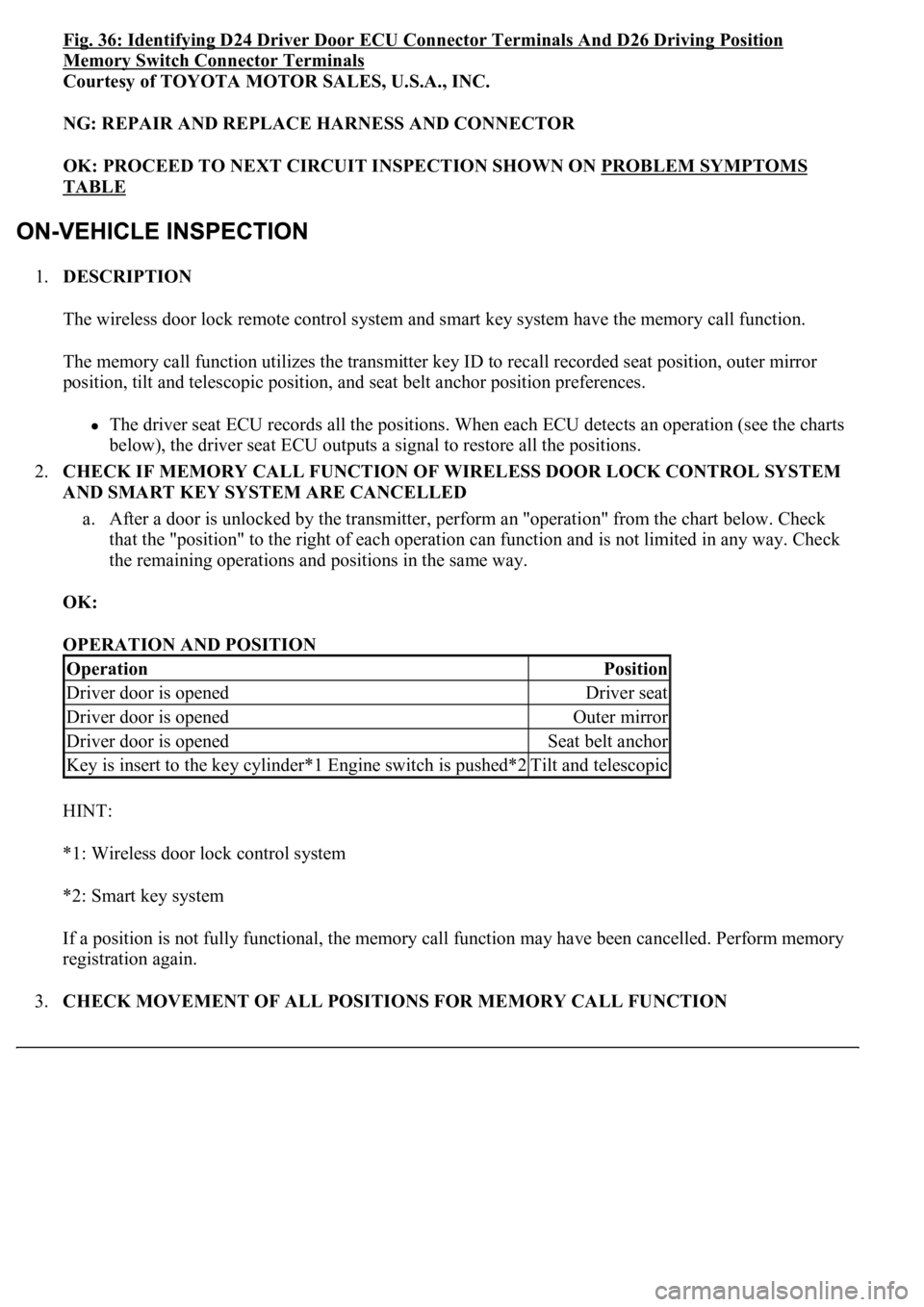
Fig. 36: Identifying D24 Driver Door ECU Connector Terminals And D26 Driving Position
Memory Switch Connector Terminals
Courtesy of TOYOTA MOTOR SALES, U.S.A., INC.
NG: REPAIR AND REPLACE HARNESS AND CONNECTOR
OK: PROCEED TO NEXT CIRCUIT INSPECTION SHOWN ON PROBLEM SYMPTOMS
TABLE
1.DESCRIPTION
The wireless door lock remote control system and smart key system have the memory call function.
The memory call function utilizes the transmitter key ID to recall recorded seat position, outer mirror
position, tilt and telescopic position, and seat belt anchor position preferences.
The driver seat ECU records all the positions. When each ECU detects an operation (see the charts
below), the driver seat ECU outputs a signal to restore all the positions.
2.CHECK IF MEMORY CALL FUNCTION OF WIRELESS DOOR LOCK CONTROL SYSTEM
AND SMART KEY SYSTEM ARE CANCELLED
a. After a door is unlocked by the transmitter, perform an "operation" from the chart below. Check
that the "position" to the right of each operation can function and is not limited in any way. Check
<0057004b004800030055004800500044004c0051004c0051004a0003005200530048005500440057004c00520051005600030044005100470003005300520056004c0057004c0052005100560003004c005100030057004b00480003005600440050004800
03005a0044005c001100030003[
OK:
OPERATION AND POSITION
HINT:
*1: Wireless door lock control system
*2: Smart key system
If a position is not fully functional, the memory call function may have been cancelled. Perform memory
registration again.
3.CHECK MOVEMENT OF ALL POSITIONS FOR MEMORY CALL FUNCTION
OperationPosition
Driver door is openedDriver seat
Driver door is openedOuter mirror
Driver door is openedSeat belt anchor
<002e0048005c0003004c00560003004c0051005600480055005700030057005200030057004b00480003004e0048005c00030046005c004f004c0051004700480055000d0014000300280051004a004c0051004800030056005a004c00570046004b000300
4c00560003005300580056004b00480047000d0015[Tilt and telescopic
Page 3966 of 4500
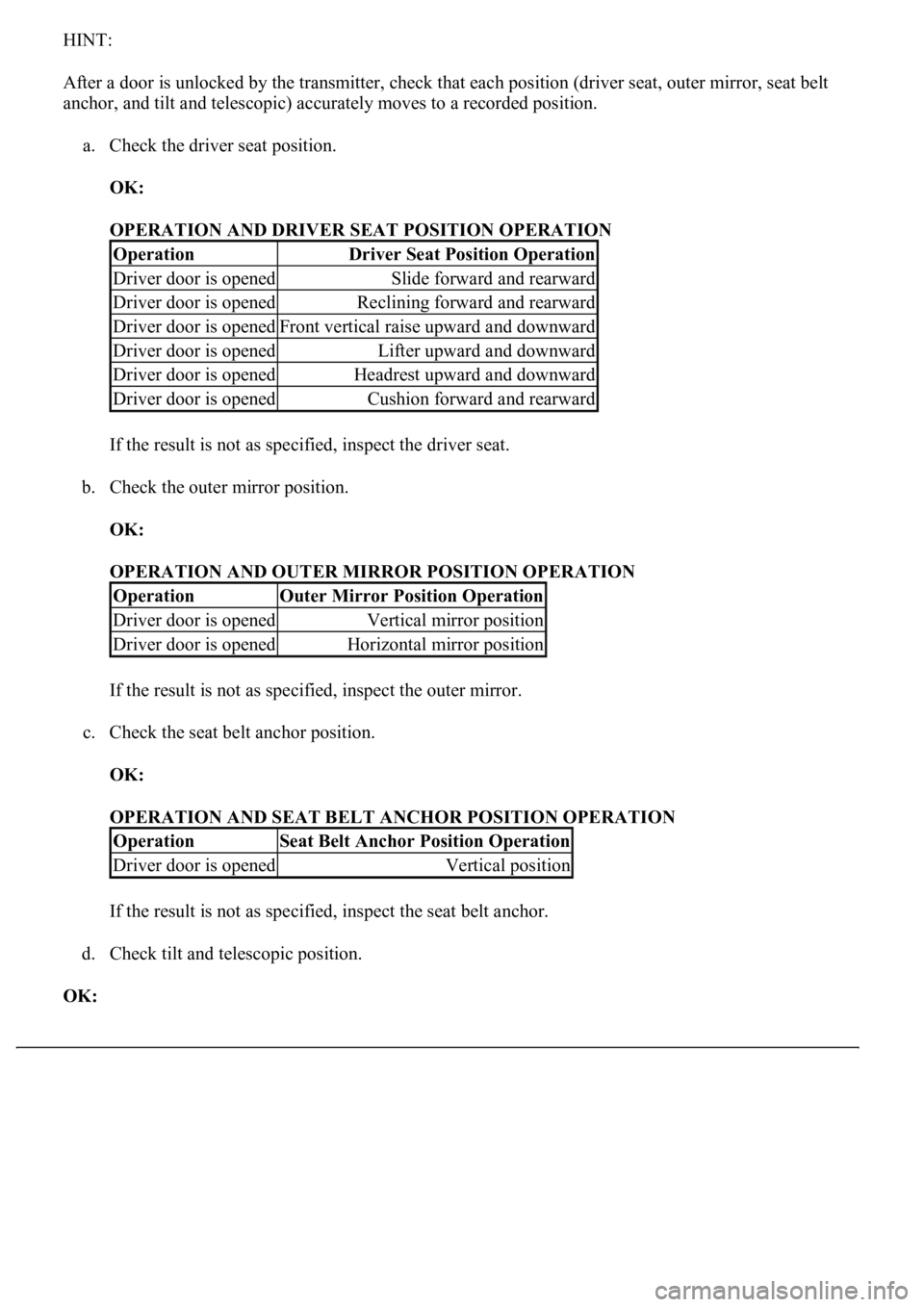
HINT:
After a door is unlocked by the transmitter, check that each position (driver seat, outer mirror, seat belt
anchor, and tilt and telescopic) accurately moves to a recorded position.
a. Check the driver seat position.
OK:
OPERATION AND DRIVER SEAT POSITION OPERATION
If the result is not as specified, inspect the driver seat.
b. Check the outer mirror position.
OK:
OPERATION AND OUTER MIRROR POSITION OPERATION
If the result is not as specified, inspect the outer mirror.
c. Check the seat belt anchor position.
OK:
OPERATION AND SEAT BELT ANCHOR POSITION OPERATION
If the result is not as specified, inspect the seat belt anchor.
d. Check tilt and telescopic position.
OK:
OperationDriver Seat Position Operation
Driver door is openedSlide forward and rearward
Driver door is openedReclining forward and rearward
Driver door is openedFront vertical raise upward and downward
Driver door is openedLifter upward and downward
Driver door is openedHeadrest upward and downward
Driver door is openedCushion forward and rearward
OperationOuter Mirror Position Operation
Driver door is openedVertical mirror position
Driver door is openedHorizontal mirror position
OperationSeat Belt Anchor Position Operation
Driver door is openedVertical position
Page 3967 of 4500
OPERATION AND TILT AND TELESCOPIC POSITION OPERATION
HINT:
*1: Wireless door lock control system
*2: Smart key system
If the result is not as specified, inspect the tilt and telescopic.
4.CHECK FRONT POWER SEAT FUNCTION
a. Check the basic functions.
1. Operate the power seat switches and check to make sure each seat function works:
Sliding
Front vertical
Lifter
Reclining
Lumbar support
Cushion sliding
Headrest
OperationTilt and Telescopic Position Operation
Key is inserted to the key cylinder*1 Engine switch is
pushed*2Vertical tilt position
Key is inserted to the key cylinder*1 Engine switch is
pushed*2Telescopic flexibility (lengthening and
shortening)
Page 3971 of 4500
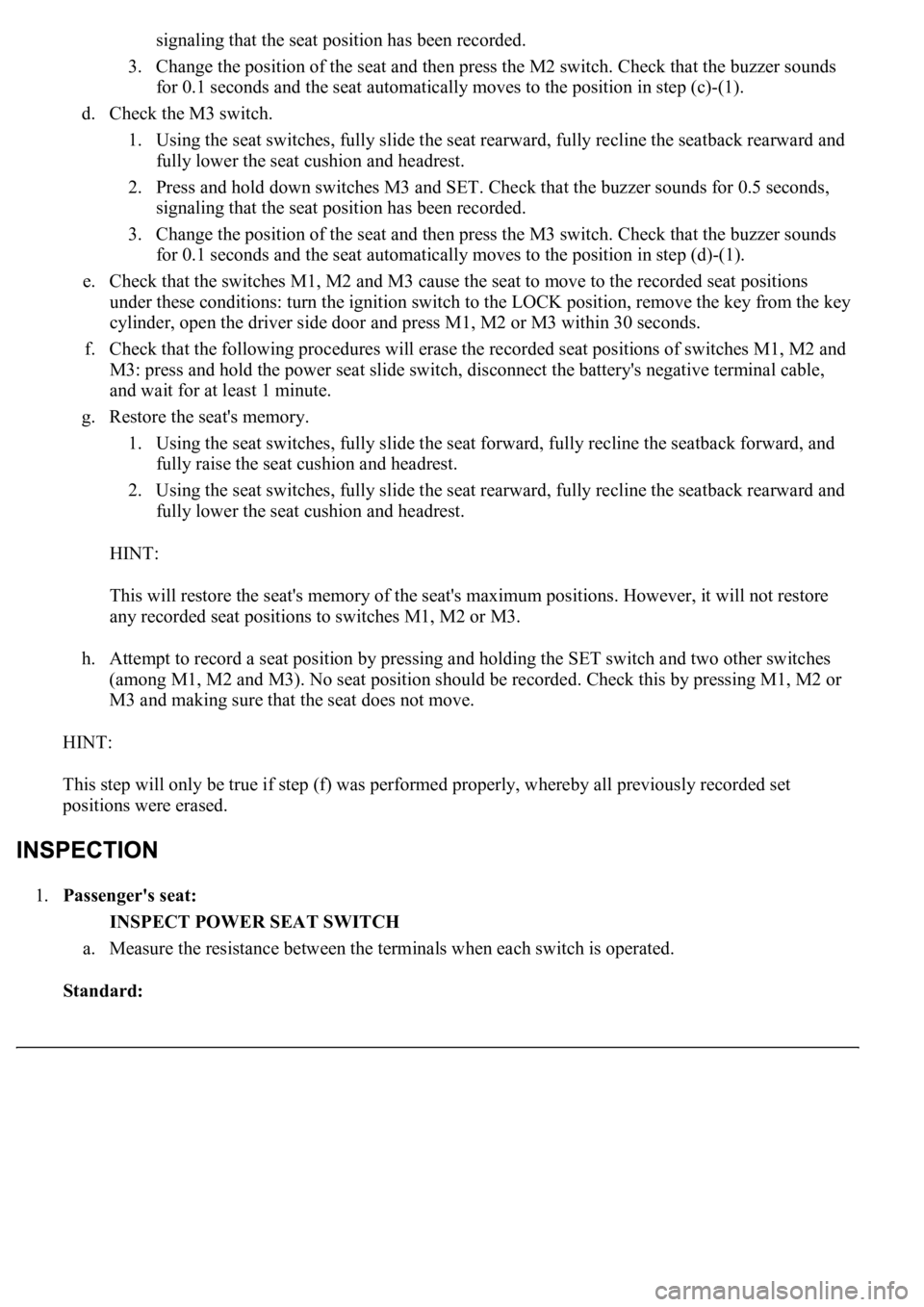
signaling that the seat position has been recorded.
3. Change the position of the seat and then press the M2 switch. Check that the buzzer sounds
for 0.1 seconds and the seat automatically moves to the position in step (c)-(1).
d. Check the M3 switch.
1. Using the seat switches, fully slide the seat rearward, fully recline the seatback rearward and
fully lower the seat cushion and headrest.
2. Press and hold down switches M3 and SET. Check that the buzzer sounds for 0.5 seconds,
signaling that the seat position has been recorded.
3. Change the position of the seat and then press the M3 switch. Check that the buzzer sounds
for 0.1 seconds and the seat automatically moves to the position in step (d)-(1).
e. Check that the switches M1, M2 and M3 cause the seat to move to the recorded seat positions
under these conditions: turn the ignition switch to the LOCK position, remove the key from the key
cylinder, open the driver side door and press M1, M2 or M3 within 30 seconds.
f. Check that the following procedures will erase the recorded seat positions of switches M1, M2 and
M3: press and hold the power seat slide switch, disconnect the battery's negative terminal cable,
and wait for at least 1 minute.
g. Restore the seat's memory.
1. Using the seat switches, fully slide the seat forward, fully recline the seatback forward, and
fully raise the seat cushion and headrest.
2. Using the seat switches, fully slide the seat rearward, fully recline the seatback rearward and
fully lower the seat cushion and headrest.
HINT:
This will restore the seat's memory of the seat's maximum positions. However, it will not restore
any recorded seat positions to switches M1, M2 or M3.
h. Attempt to record a seat position by pressing and holding the SET switch and two other switches
<000b0044005000520051004a000300300014000f0003003000150003004400510047000300300016000c0011000300310052000300560048004400570003005300520056004c0057004c0052005100030056004b00520058004f0047000300450048000300
550048004600520055004700480047001100030026004b0048[ck this by pressing M1, M2 or
M3 and making sure that the seat does not move.
HINT:
This step will only be true if step (f) was performed properly, whereby all previously recorded set
positions were erased.
1.Passenger's seat:
INSPECT POWER SEAT SWITCH
a. Measure the resistance between the terminals when each switch is operated.
Standard:
Page 3983 of 4500
Fig. 44: Identifying Power Seat Cushion Switch Connector Terminals - Passenger Seat
Courtesy of TOYOTA MOTOR SALES, U.S.A., INC.
7.INSPECT POWER SEAT MOTOR
a. Check operation of the slide motor.
1. Check if the motor rotates smoothly when the battery is connected to the slide motor
connector terminals.
OK:
MEASUREMENT CONDITION AND SPECIFIED CONDITION
If the result is not as specified, replace the slide motor.
Measurement ConditionSpecified Condition
Battery positive (+) --> 1 Battery negative (-) --> 2Counterclockwise
Battery positive (+) --> 2 Battery negative (-) --> 1Clockwise